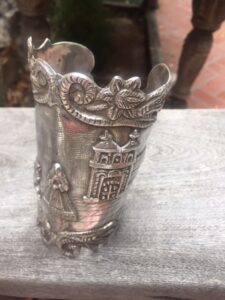 RF collects unique pieces of South American silver. He sent these photos of a pair of ceremonial lady’s silver stirrups, very tiny, and a solid sterling cuff bracelet. At four-and-a-half inches tall the cuff, a “story-telling” bracelet, rose to popularity in the 1940s. They often tell tales of the indigenous past, relating to ancient history of civilizations like the Inca, Maya, and also stories of 19th century Colonial presence in South and Central America. Mainly tourist collected pieces, not made by particular jewelers, but oftentimes made of solid sterling. They often used lesser quality metal, with not as much silver content. The best of these are “statement” pieces, not wearable daily!
RF collects unique pieces of South American silver. He sent these photos of a pair of ceremonial lady’s silver stirrups, very tiny, and a solid sterling cuff bracelet. At four-and-a-half inches tall the cuff, a “story-telling” bracelet, rose to popularity in the 1940s. They often tell tales of the indigenous past, relating to ancient history of civilizations like the Inca, Maya, and also stories of 19th century Colonial presence in South and Central America. Mainly tourist collected pieces, not made by particular jewelers, but oftentimes made of solid sterling. They often used lesser quality metal, with not as much silver content. The best of these are “statement” pieces, not wearable daily!
This piece is likely Peruvian. The visual language, because it tells a story, leads from left to right. On the left foreground we see a streetlamp, ornately hanging from a bracket, under which a man drives a horse-drawn buggy. The horse, a trained prancer, raises his front leg gracefully. A woman in a 19th century style South American full length flounced skirt, accented by an indigenous apron, stands center, shrouded by a shawl covering head and shoulders. The paved Courtyard beneath adds to the perspective of the engraved design. She stands on the forecourt of a Spanish Colonial church. In the background we see the church with its two bell towers (campanarios), and a cross marks the ornate entry doors. The lower roofed nave structure flanks the tall sanctuary, finishing the composition, and the tale the piece tells.
What story does this piece tell?
Colonialism, for one, although we may perceive a romance between the horseman and the lady. The Spanish Government in the 18th to 19th century established missions located adjacent to establish indigenous settlements. This supplied the church, the “Spiritual Center” of the mission, with labor and maintenance power, while at the same time “converting” the locals to Christianity. We see the church in the style we know here in Santa Barbara: a combination of Gothic, Baroque and Classical architectural elements. Historians today rethink the philosophy of the missions, in the 1940s they considered them romantic, the aura of Spanish Romance mixed with local flavor.
The bracelet, popular today as a “Frida” inspired piece, as Frida Kahlo wore massive pieces like this in indigenous styles. Heavy, and pure sterling, the value of the piece is $750.
Delightful Tiny Stirrups (Estribos)
 Made for a noblewoman with fashionable tiny feet in 1880-1890, in Argentina, and not meant for heavy riding, but for show. Other Spanish Colonial forms of estribos are more massive, larger shoe-form, often with the toes in an unique Asian inspired curl. WHY?
Made for a noblewoman with fashionable tiny feet in 1880-1890, in Argentina, and not meant for heavy riding, but for show. Other Spanish Colonial forms of estribos are more massive, larger shoe-form, often with the toes in an unique Asian inspired curl. WHY?
The history of the stirrup starts in Asia. Chinese stirrups spread to Europe in the first few centuries AD through nomadic tribes of Central Eurasia. In fact, the Chinese Jin Dynasty “paired” stirrups became popular with European nobility in the Medieval period.
How do we know European stirrups came from a Chinese form? Chinese buried their noblemen, horsemen, and soldiers WITH their prized paired stirrups. The earliest found in a Chinese tomb dating to 415 AD. Funerary terracotta figures of mounted noblemen clearly showed stirrups from 302 AD.
We compare those forms from China with drawings and murals in medieval Europe of mounted warriors and equipage processions. For example an illustration from 867 AD depicts Basil I, Byzantine Emperor, mounted with Asian inspired stirrups.
Stirrups Spread Culture
Metal stirrups continue this design feature of the shoe-stirrup with the slight curl to the toe in Spanish Colonial brass and silver stirrups. Also seen in wood forms and the brass flatter toed shoe-stirrups from Europe and England, till the 19th century. India used a similar curled toe shoe-stirrup dating as far back as 2 century BCE.
In fact, stirrups MAY be considered one of the most influential tools of civilization, “helping along” the spread of cultures, along with equally important tools such as the wheel, and the printing press. WHY? Without the stirrup a rider has little control of the horse. This makes the horse and stirrup influential in the spread of populations, communication, and the art of war for millennia. Historian Zaheer Baber said as much in his 1996 book, The Science of Empire: Scientific Knowledge, Civilization and Colonial Rule.
The value of the little Argentina late 19th century stirrups is $300.